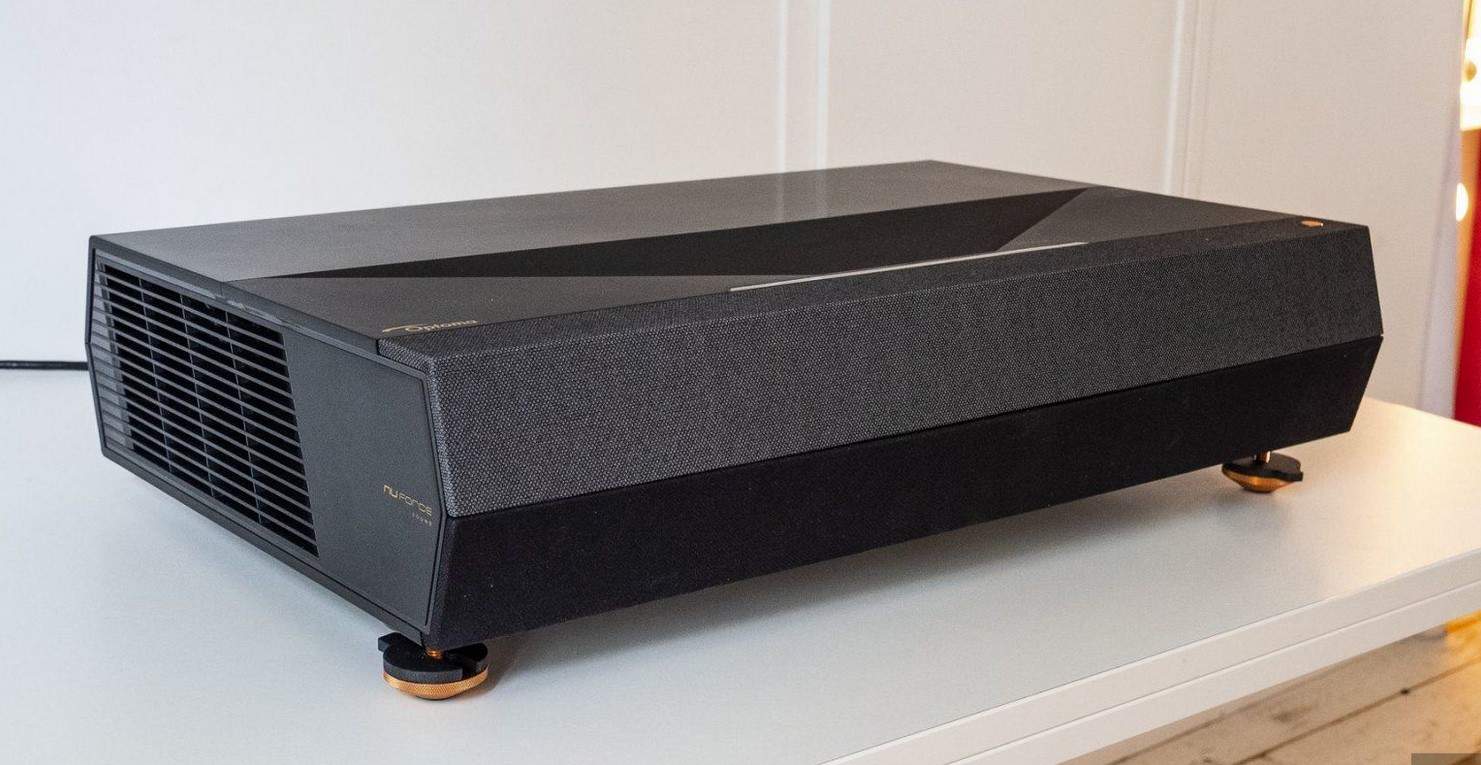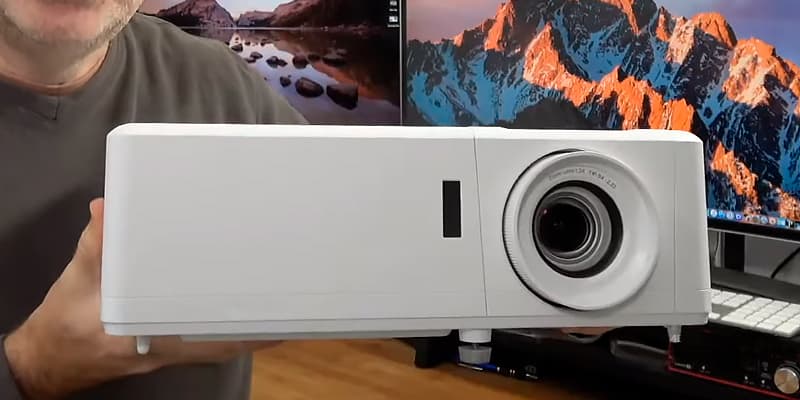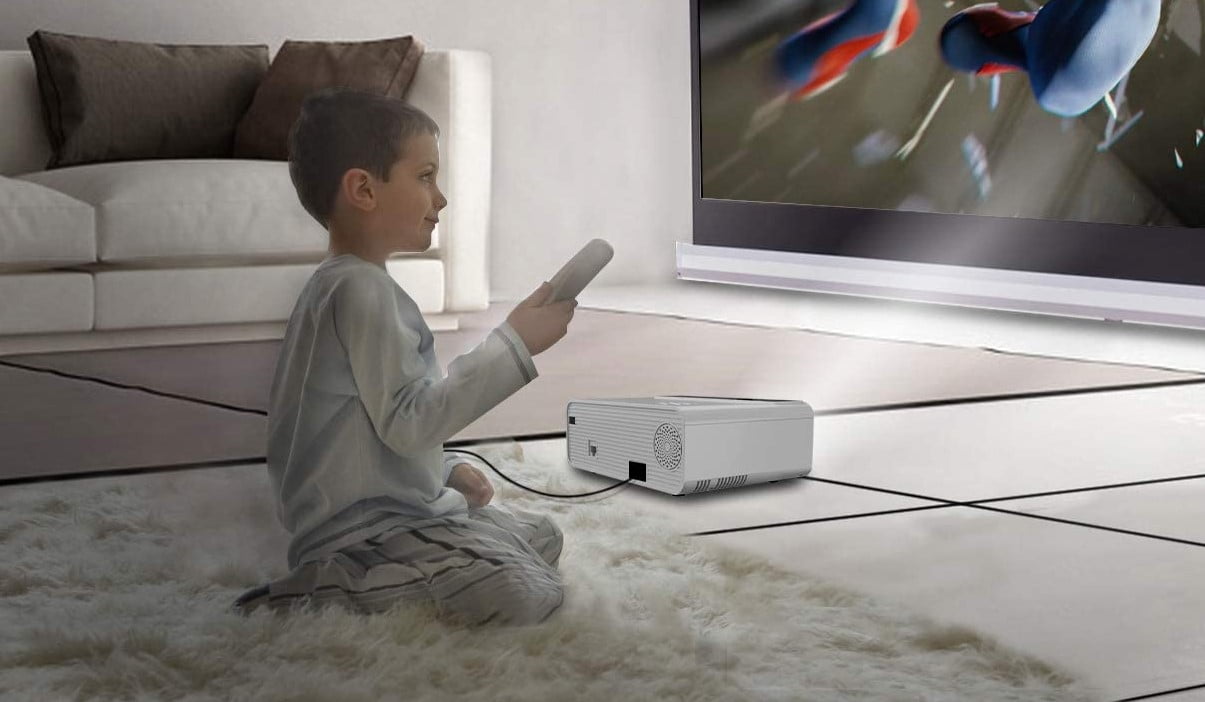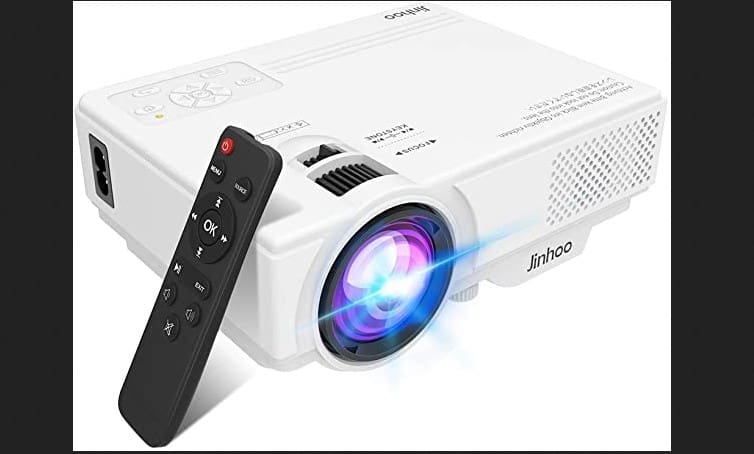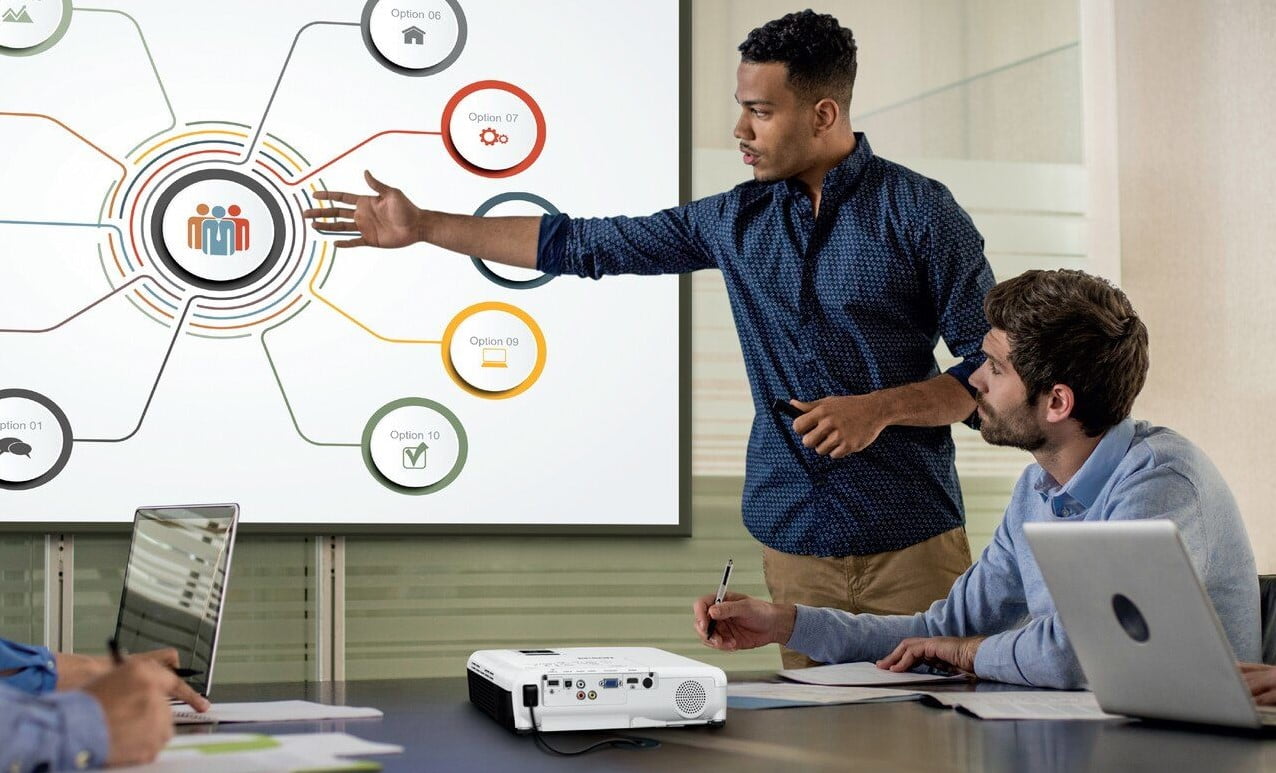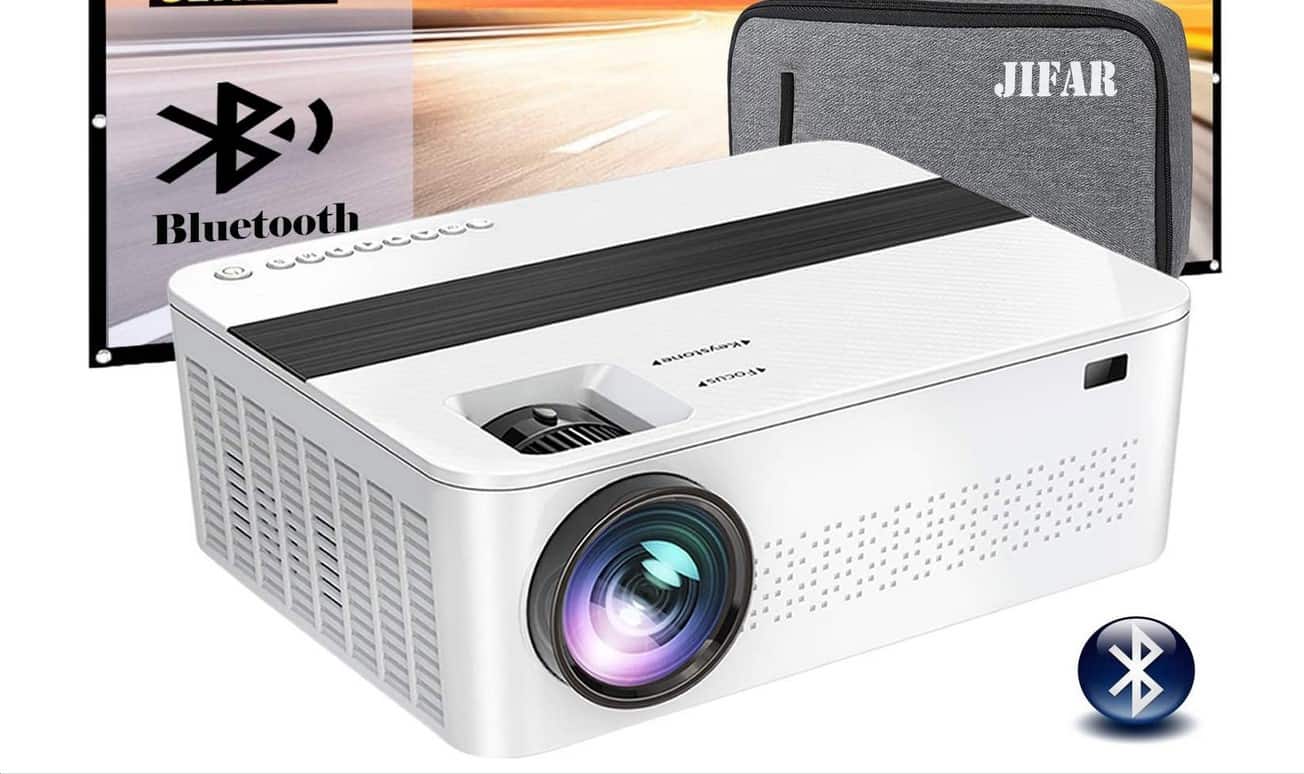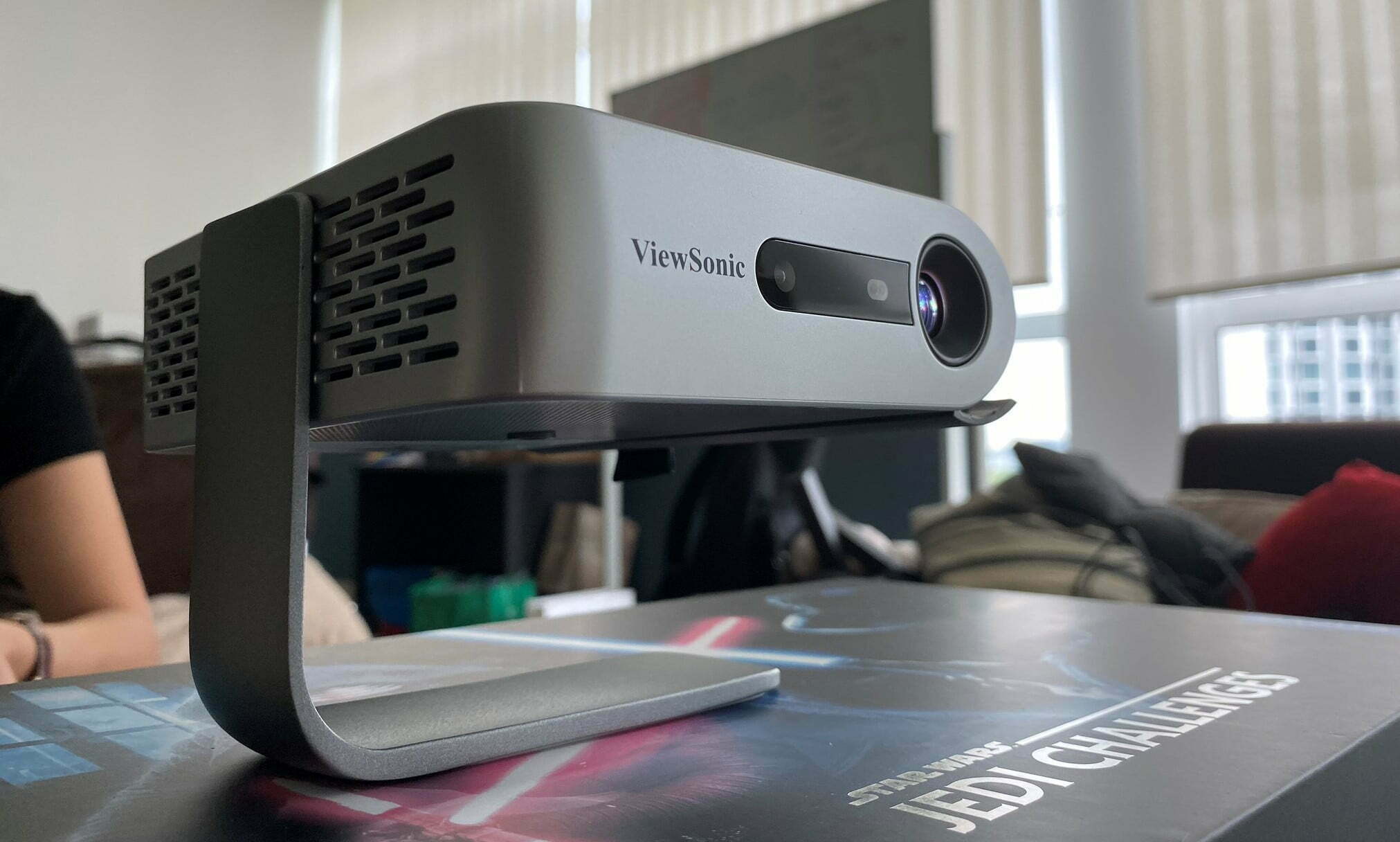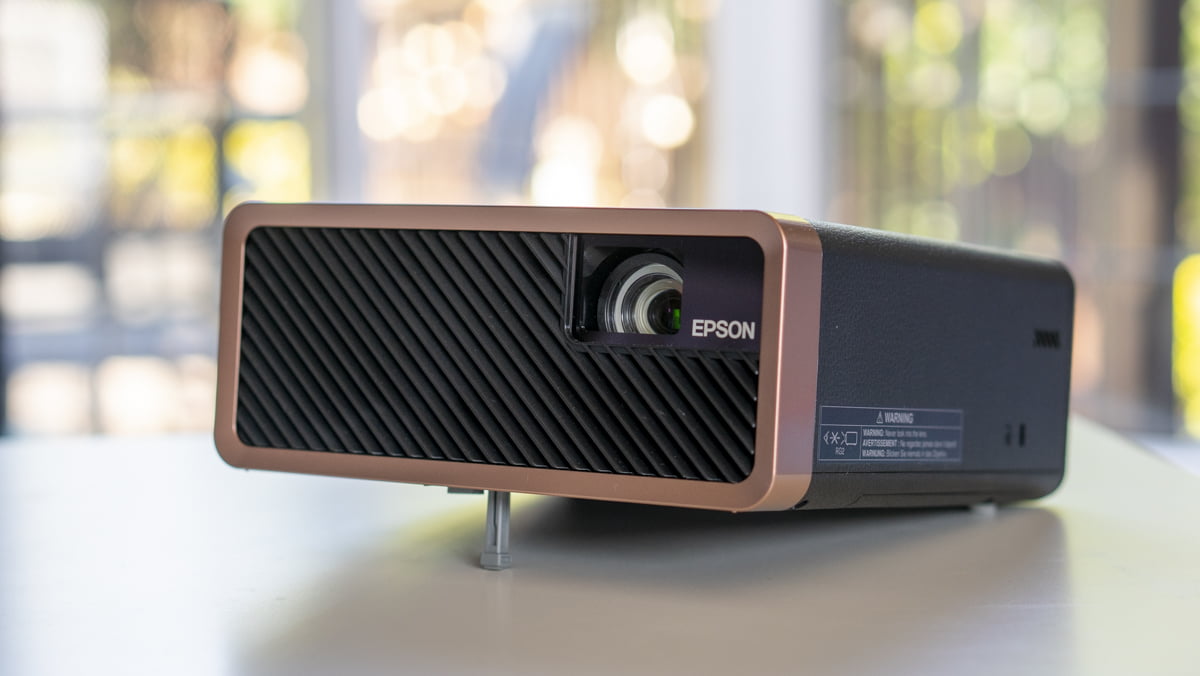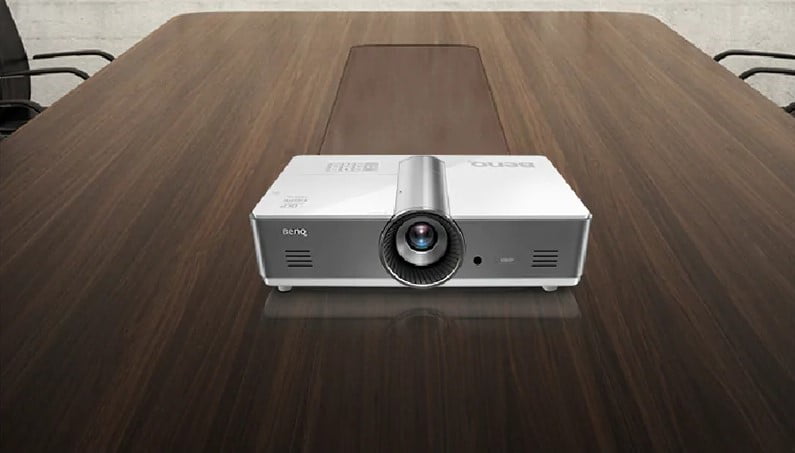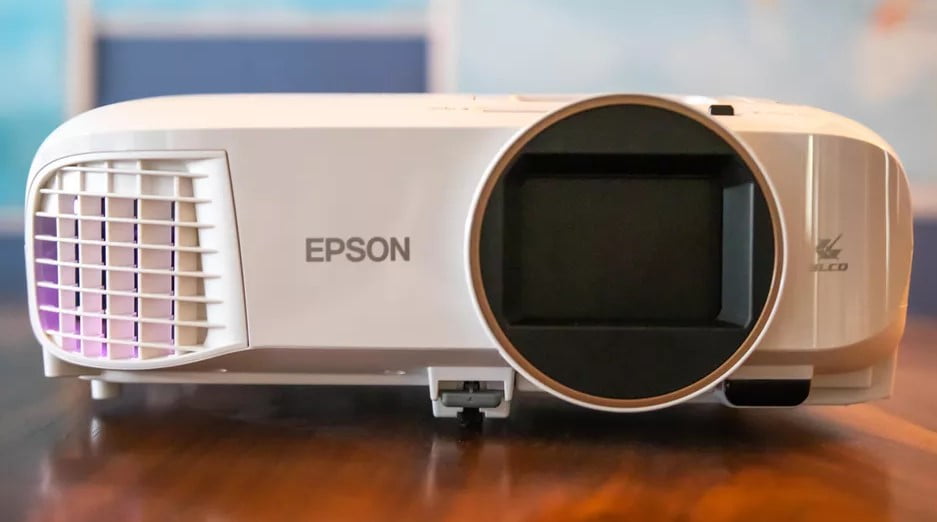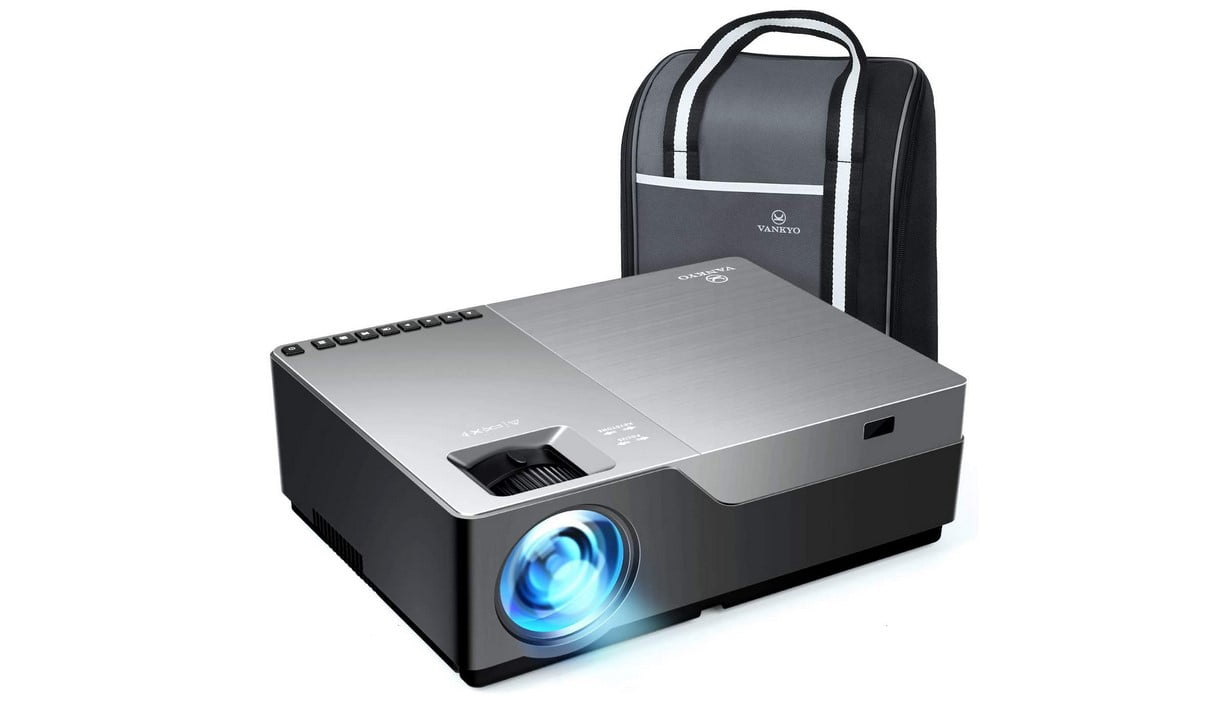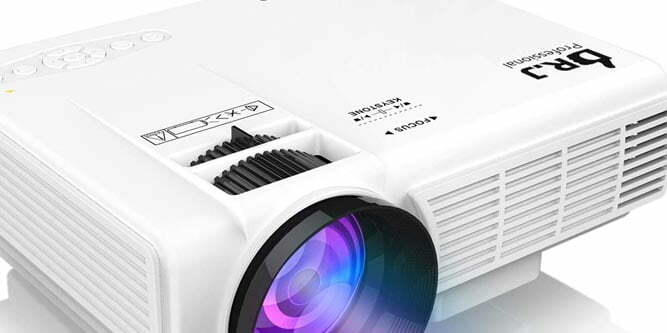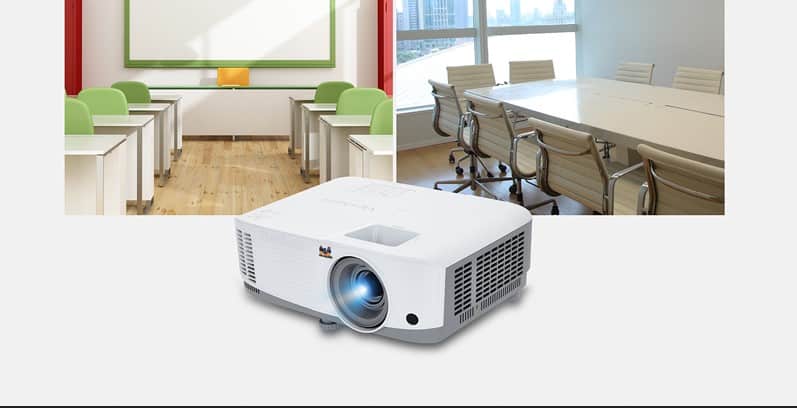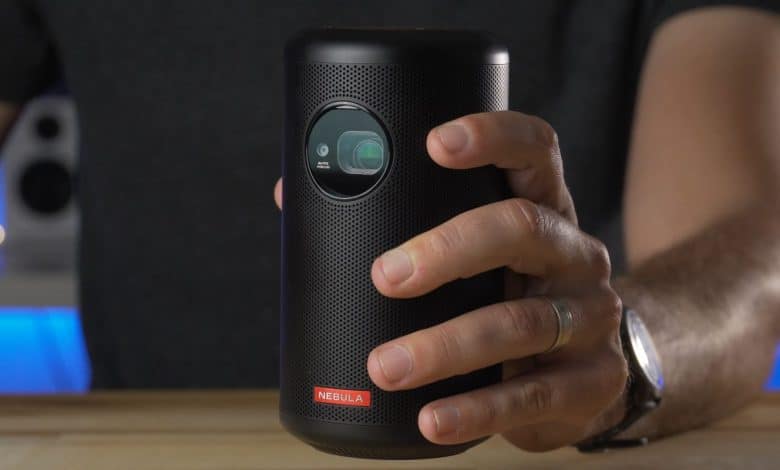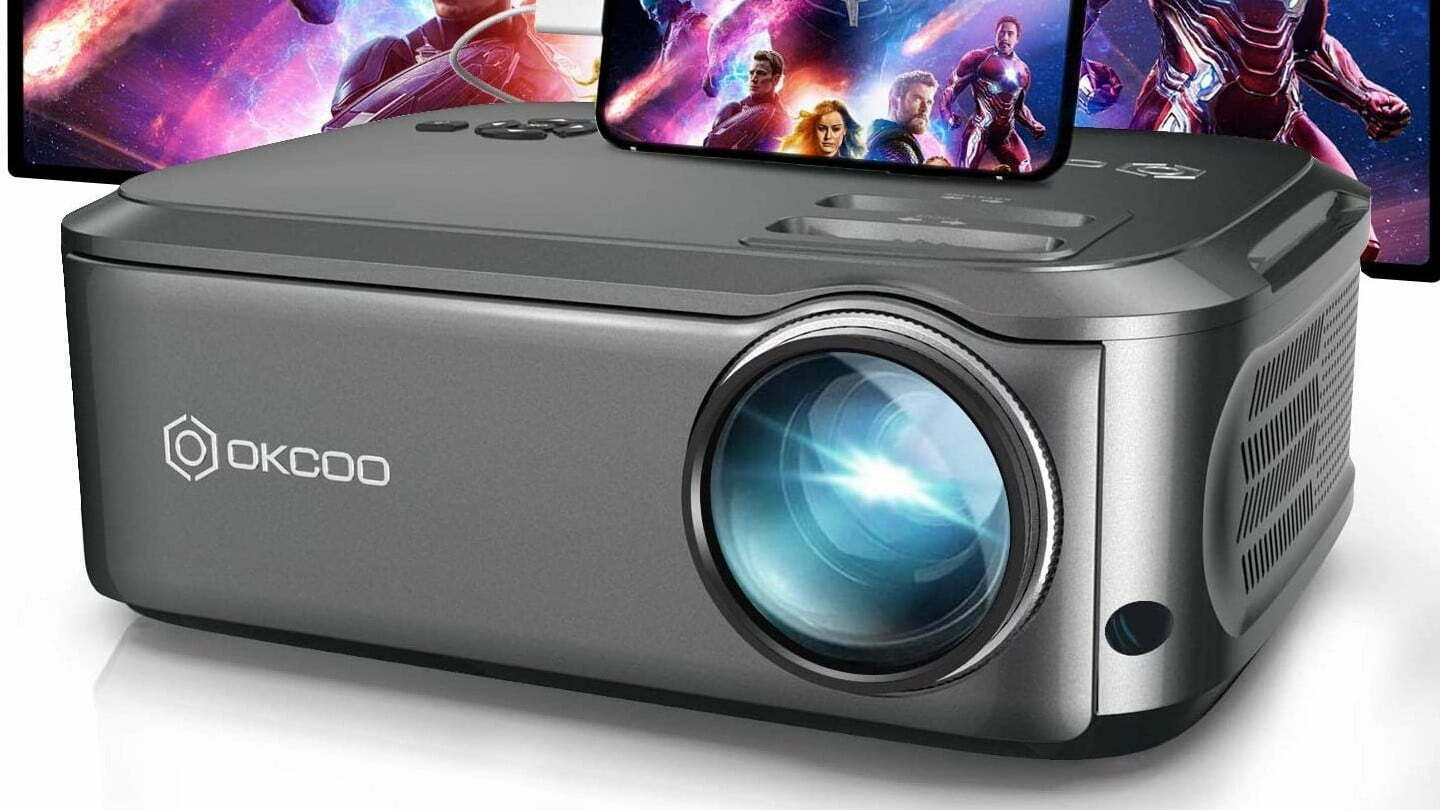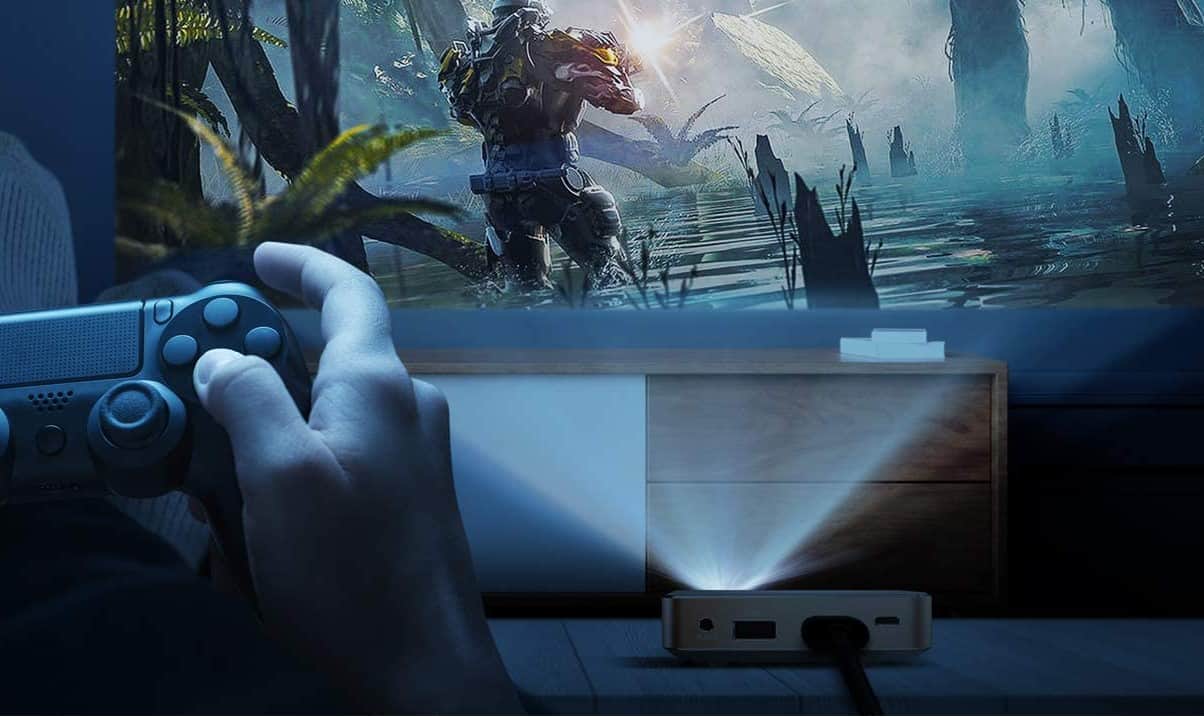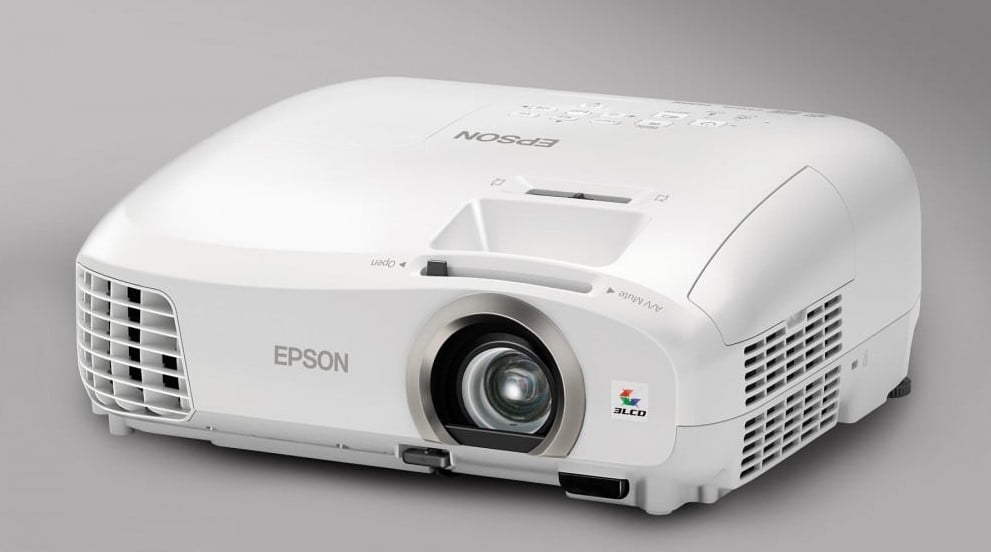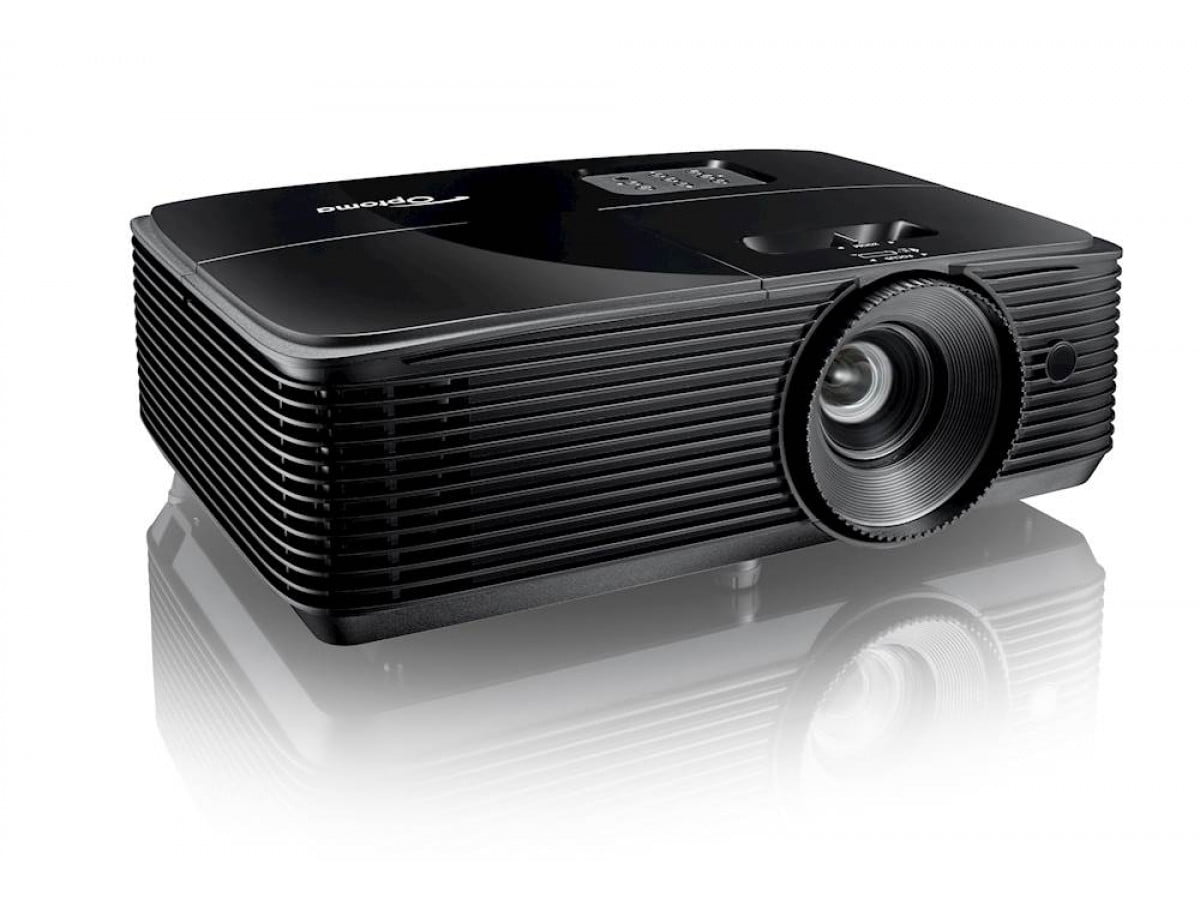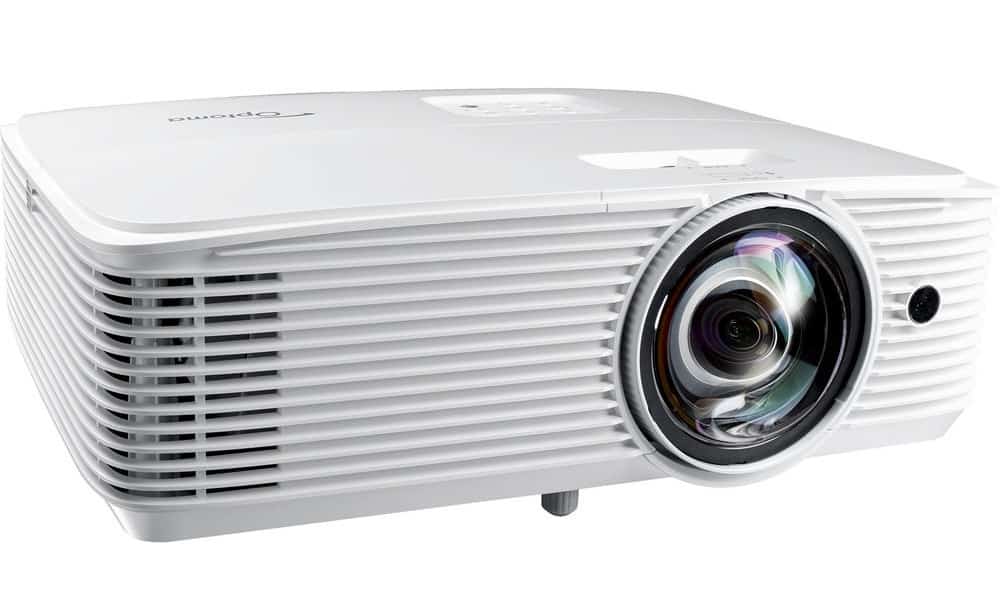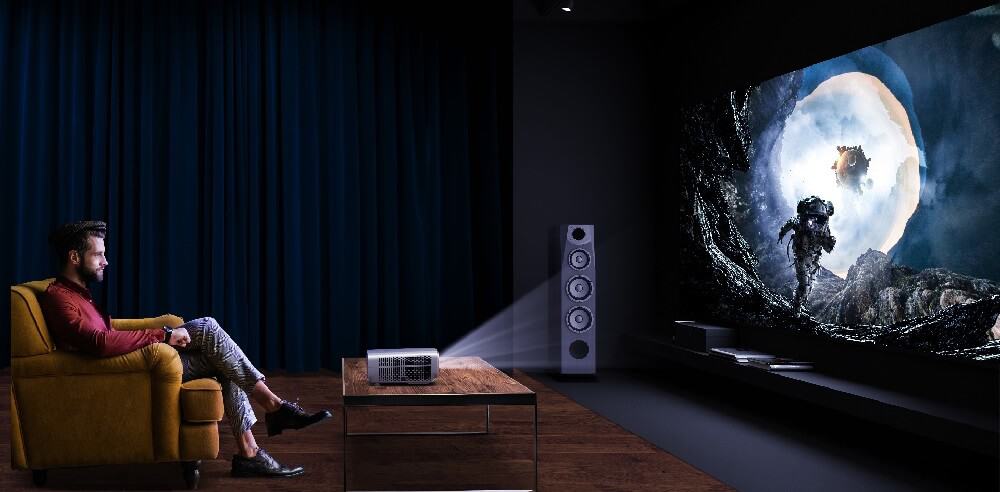What are the features that make the best conference room projector? These devices offer a high brightness level, tons of connectivity options, and a sharp picture quality, thanks to Full HD native resolution. Because of these features, these devices are the best projectors to use in business meetings.
If you’re looking for something to make presentations in your office’s conference rooms or you’re a traveling business person who needs to make presentations on the go, a conference room projector can be a huge help. With their high light output and user-friendly designs, these projectors will get your meetings going without a hitch and keep them running smoothly.
Keep reading to learn more about the best conference room projectors, their key features, and how these office projectors can help elevate your business or lecture hall.
Top Conference Room Projectors
#1 Optoma EH412 Projector
Award: TOP PICK
WHY WE LIKE IT: This is a great model for those that need multifunctionality in their projector. You can use it for any number of reasons, including presenting to groups. It also has an internal sound system.
- Multifunctional model
- Internal sound system
- Compact design
- Poor HDR quality
Those seeking high brightness will love what this model has to offer. You’ll enjoy 4,500 lumens of brightness that ensures you can always see imagery clearly. This should be enough to contend with some ambient lighting, as well. Unfortunately, a few consumers reported that this projector does not offer a true high-definition resolution. Because of this, the picture might not be up to par with some competing models.
It also has extensive connectivity options so that you can choose whatever suits you best. You’ll have 2 HDMI ports, audio-in and audio-out, VGA-in and VGA-out, and even a USB-A port. There is an integrated speaker, which means you won’t have to add extra wires or devices unless you want to. This speaker has 10 watts of power, meaning it’ll be loud enough for the entire conference room to hear the audio.
#2 CiBest Home Theater Projector
Award: HONORABLE MENTION
WHY WE LIKE IT: This model accepts multiple connections, so you won’t have to worry about setting it up. Beyond this, it’s a small projector that allows for high maneuverability. You’ll also appreciate the inclusion of light-emitting diodes.
- High maneuverability
- Accepts multiple connections
- Light emitting diodes
- May have subpar Image brightness
Those seeking an immersive visual experience will find it with this projector model. It provides a superior image quality compared to competing models in the same class. You’ll enjoy 1080P, which is a full high-definition resolution. However, the brightness is not quite up to standard with competing models in the same class. This might be a dealbreaker, especially if you’re going to be in a room that deals with a lot of ambient light.
The 2000:1 contrast ratio ensures you’ll have lifelike detail, so presentations will always be crisp and clear. There is diffuse reflection technology included, which provides a softening to imagery. This helps protect you against eye strain. Multiple devices are compatible with this projector, including the Amazon Firestick, PS4, USB flash drive, TF card, laptops, and more. The leading smartphone projectors offer similar connectivity options. You’ll have precision control over the set-up of any presentation you have to give.
#3 Bundled LH720 Projector
We’re sorry, this product is temporarily out of stock
Award: BEST FOR SOUND SYSTEM
WHY WE LIKE IT: The short throw ratio on this model means you don’t need nearly as much space for your projections. This best projector for small meeting rooms won’t be an issue. Beyond this, it provides a whopping 4,000 lumens of brightness.
- 10 watt speaker
- 4,000 lumen brightness
- Short throw ratio
- Might be too bulky
This high-brightness model ensures that ambient light won’t be a problem during presentations. You can expect 4,000 lumens of brightness from this projector, which is significantly higher than many competing models. Combine that with its full HD resolution, which is 1920 x 1080 pixels, and you have a fantastic picture every time. Keep in mind that this is a bulkier model than some counterparts. Because of this, you might want to go with a different model if you need high portability.
It also has a remote control, meaning you have total control over the projector no matter where you are in the room. The throw ratio is very low, as well. This means you don’t need a ton of space to properly project imagery onto your screen. Finally, you’ll appreciate the inclusion of a built-in speaker that offers 10 watts of power. This means that you don’t have to add an external sound system unless you want to. This speaker should be loud enough.
#4 ViewSonic PA503S Projector
Award: BEST FOR LOW LATENCY
WHY WE LIKE IT: You’ll appreciate the low latency design of this powerful model. It also provides accurate colors, so you’ll always have a vivid image with precise details. This is a Blu-Ray-ready model that has multiple input options.
- Reduced input latency
- Provides accurate colors
- Blu-Ray-ready design
- Longer throw distance
This multifunctional model has a lot to offer, no matter what you’re going to be using it for. If you choose to put this in a conference room, you can easily use it for presentations. It can also display high-resolution movies and informational content of all types. Unfortunately, this is a model with a longer throw distance. Because of this, you’ll need a fair amount of room to properly project imagery. This might be a dealbreaker for some consumers.
It also projects a large image. You’ll have 120 inches of room to play with if you keep it around 16 inches away from the projector screen. The easy set-up process is a dream for consumers and shouldn’t take more than a few minutes. All you have to do is plug it in, plug in your equipment of choice, and you should be ready to go. The SuperEco mode increases lamp longevity, helping the projector reach 15,000 hours of lamp life before requiring a replacement.
#5 TMY Projector
Award: BEST FOR EASY SET-UP
WHY WE LIKE IT: If you want a projector that’s easy to get up and running, this model goes as far as to include a projection screen. It also has Keystone Correction, allowing you to adjust the imagery easily. You’ll appreciate the enhanced color contrast ratio.
- Projection screen included
- Enhanced color contrast ratio
- Keystone correction
- Overall brightness is lacking
This super-portable model is great for those who need to move the projector from room to room regularly. It’s a relatively small model that transports well. It also provides the newest 3LCD color, and it both calibrates and adjusts automatically to ensure you always have an accurate picture. While this is an excellent projector for dark rooms, it might struggle with ambient lighting. A few consumers said that it’s not nearly as bright as they hoped when they invested in it.
When you choose this projector, you’ll experience a genuinely vivid 1080P HD experience. Compared to competing models of mini projectors, it has a far better image quality. Depending on the projector’s distance from the screen, you can reach between 32” and 220” of screen space. It’s able to project correctly between 1.5- and 6-meters. This gives you precision control over the size of the projection and how close you want it to be to the screen.
#6 FANGOR F506 Projector
Award: BEST FOR WIRELESS CONNECTIVITY
WHY WE LIKE IT: You’ll appreciate the inclusion of an entire accessory kit with this projector. It’s also a wireless connectivity model, making connecting with your phone a breeze. Beyond this, multiple different inputs are accepted.
- Full accessory kit
- Wireless connectivity
- Multiple inputs accepted
- Fan might be loud
You’ll receive multiple different accessories with your purchase of this projector. There is a carrying case to keep this model extra portable and a tripod to help you get set up so much quicker. This miniature version is not much larger than a phone, which means it can easily be transported around as necessary. However, it has been reported that the fan is noisy. You’ll have to contend with it while giving presentations, which may be a dealbreaker.
There are multiple devices compatible with this model. You’ll be able to use HDMI, AV, SD cards, or even VGA. This provides precision control over using the connection type of your choice, making the set-up even more straightforward. It also has Bluetooth connectivity, so you can connect external speakers to play audio. If you prefer to skip the external speaker, it also has one built-in for your convenience. The lens is an innovative 6-layer glass with high refraction.
What Are Conference Room Projectors?
A conference room projector is a video projector that connects directly to a media source, like a computer, laptop, or media drive, to display high-quality images, video, and audio. The projector uses a light source and a series of lenses or glass panels to reproduce and enlarge the source media onto a projection surface to be viewed with clarity, even from many feet away.
Conference room projectors are built to create large images that can be seen by larger groups of people in larger rooms. These devices are incredibly helpful to deliver important information to a group of co-workers, stakeholders, or clients in a controlled environment.
Conference Room Projectors vs Traditional Projectors
Both conference room projectors and traditional video projectors operate in much the same way, depending on the exact type you have on hand. At their core, both styles of projector will connect to a source like a computer, tablet, or media drive through any number of connections like an HDMI port, USB port, or VGA port. Some can even connect via wireless connection options. Once connected, the projector will project the media onto your projection screen or wall.
Whether you have a conference room projector or standard projectors, you’ll also get the same basic set of components. These typically include a light source, a color wheel or colored panels, and a lens. However, there are specific key differences in the way these features work that make conference room projectors better suited for office use, including:
- Brightness: Conference rooms are more likely brightly lit than not, meaning your projector in that room will need to offer a higher level of brightness than theater projectors. In general, you should only consider a projector for your conference room that has between 3,000 and 6,000 lumens of brightness.
- Resolution and Image Quality: Conference room projectors typically don’t need the highest projector resolution available on the market. You’ll want to be able to see your presentations and text clear enough to understand, but you won’t need the more accurate colors or sharpest details. As such, the best of these projectors will typically offer a 1080p, Full HD resolution, or a 720p resolution. You can even get away with SVGA resolution on a business projector, which is 800×600 pixels.
- Throw Distance: In general, most conference room projectors will be long-throw projectors, with a throw distance of six feet or more. These projectors can produce images upwards of 100 inches in size without a problem and without getting in the way of the meeting attendees.
- Connectivity: With all of the different devices available in the modern-day office setting, conference projectors should be able to connect to most, if not all, of those different options. These devices tend to offer a wide range of connection options, including both network and wireless connectivity.
How Conference Room Projectors Work
While all video projectors operate in the same core way – projecting light and images to a flat surface — the exact mechanics of that process depend on the specific type of projector you’ve purchased. Let’s take a look at the three most common types of projectors you may find in a conference room:
- LCD: Liquid Crystal Display (LCD) projectors are lamp-based projectors and use a series of polarized mirrors and LCD panels to display your source media. The lamp shines a light through red, green, and blue LCD panels to create the color and then combines them into a single, colorful image. LCD projectors tend to offer more accurate and vivid color, as well as a more affordable price tag.
- DLP: Digital Light Processing (DLP) projectors feature a lamp for the light source and a multitude of pivoting microscopic mirrors and color wheel to display your source media. The lamp shines a light through the color wheel to create the color and then uses the mirrors and a digital chip to process and display the image. DLP projectors tend to offer sharper images overall and the devices are more portable than other types.
- Laser: Laser projectors use three different lasers as a light source and a series of mirrors to magnify and project the image. Laser projectors are more energy-efficient and long-lasting, with more detailed images overall, but they are much more expensive and bulky than other types of projectors.
Do You Really Need a Conference Room Projector?
Whether you’re a business owner, team leader, or traveling salesperson, a conference room projector can amplify your ability to present helpful and important information to your audience. You might be in the market for a new projector if you’re opening a new office, replacing a worn-out device, or simply looking for new tools to improve your workflow. All of these are excellent reasons for considering the best conference room projector.
Is a Conference Room Projector Worth Buying?
- You’re a Team Leader or Manager: Team leaders, managers, and executives regularly hold meetings with presentations. If you’ve had a hard time effectively communicating your points during these meetings, then a conference room projector can help elevate your presentations. When you have a projector on hand, you can display figures, numbers, and growth trajectories to your peers and teams with ease.
- You’re a Traveling Business Person: Traveling sales teams often need to give presentations in settings where they don’t have any previous control. With the best conference room projector, you’ll have something portable with plenty of connection options to ensure you’ll always be able to get up and running. Plus, with their high brightness levels, you’ll be sure your presentation is always visible.
- You Want Bright Projector for Any Office Application: A conference room projector is excellent for the specific use-case scenarios listed above, but it can also be a good general-use projector to have available in your office. If you’ve ever needed a projector for any reason at work, then getting the best conference room projector is a good idea.
Why a Conference Room Projector May Not Be For You
- Your Office Doesn’t Have Conference Rooms: If your office doesn’t have any conference rooms with projector screens or flat, blank walls on which you can project images, then getting a projector doesn’t really make sense for you. Instead, you’ll want to rely on computer screens or televisions.
- You Rely on Physical or Online Handouts During Meetings: If you prefer to use physical handouts or online slides that people can use on their own computers during your meetings, then a projector wouldn’t help very much.
- You Don’t Have the Budget for Projectors: Conference room projectors tend to offer a higher price tag than traditional alternatives. If your team or business doesn’t have the budget for a brand new device, then you may want to consider using the resources you already have on hand for your meetings.
How Long Will a Conference Room Projector Last?
According to experts in the projection industry, like those at CDW, the biggest component to consider when looking at your projector’s lifespan is its light source or bulb. For a standard LCD projector, you should expect your bulk to last for around 2,000 hours before it needs to be replaced. However, high-end LED bulbs and laser projectors may give you as much as 15,000 hours of use before they need to be replaced.
Of course, your bulb’s lifespan ultimately depends on how often you use the projector. If you keep it powered on 24 hours a day, 7 days a week, then you’ll only get a few short years out of it. However, if you only use it a couple of hours a week, then it could last you 20 or more years.
There are several other factors to consider with your projector’s lifespan, as well. For example, improper installation could cause long-lasting problems that decrease your device’s lifespan. Similarly, keeping your projector in a dusty and dirty environment could also cause a decrease in lifespan.
How to Choose the Best Conference Room Projector
Before purchasing a new, leading projector for your classroom, you’ll want to consider the key features and functionalities you’ll need. For starters, consider the way you plan on using your projector while you present. This can help you determine what kind of user-facing controls are best for your presentation style. Next, consider how much ambient light is in your conference room so you can decide how many lumens you’ll want. Finally, think about connectivity and how you’ll connect to mobile devices and computers.
Conference Room Projector Key Factors to Consider
1. What throw distance do you need for your conference room?
Conference rooms come in all different shapes and sizes. As such, one of the first considerations you need to make for your new projector is how far it can project an image. This way, you’ll be able to determine where you can install it in your conference room. The following options are the most common:
- Short-Throw Projectors: Also known as standard throw projectors, these are some of the most common projectors available today. They require anywhere between three and eight feet of projection distance, and they can typically create images upwards of 100 inches in projection size. A short-throw projector is perfect for tabletop installation. Many of the best Epson projectors offer a short-throw configuration. Although, while they’re great for meetings, they can also be the best projector for golf simulators, especially during breaks.
- Ultra-Short Throw Projectors: These are more expensive and less common than standard short-throw projectors. Ultra-short throw projectors only need between a few inches and three feet to project an image. Typically, you install them directly below the projector screen. An ultra-short throw projector is perfect for small conference rooms.
- Long-Throw Projectors: These are most commonly found in conference rooms and auditoriums. They require at least six feet to project an image, but can even be installed 10 to 20 feet away for larger image sizes. Long-throw projectors are typically installed in a ceiling mount configuration.
2. How many lumens of brightness do you need your projector to output?
Conference rooms are often brightly lit, either from ceiling lights or from the daylight coming through the windows. Either way, you’ll want a projector with anywhere between 3,000 and 6,000 lumens of brightness to get a clear picture for your audience.
If you have the option of closing blinds and turning off the lights, you can likely get away with an option with less brightness. However, you’ll then create a dark environment for your audience, which is less than ideal for an office setting.
3. What kind of connectivity options do you need on your conference room projector?
Since the conference room projector you purchase will likely be a shared device amongst the rest of the office, you’ll need to consider an option with plenty of connection options. This way, everyone will be able to connect to the projector, regardless of which device they’re using.
At the very least, you should consider an option with HDMI, VGA, and USB ports. If you’re looking for more extensive connectivity, you can purchase options with DisplayPort ports, component ports, and even wireless connectivity.
You may also want to consider a projector with network connectivity. A network projector can connect remotely to any desktop computer connected to your office’s network. These can be incredibly helpful for large offices with a lot of employees.
4. Should you choose a ceiling mount projector or a tabletop projector for your conference room?
Most projectors are installed in either a ceiling mount configuration or a tabletop configuration. Each way has its own pros and cons, but the configuration you select will ultimately depend on the specific conference room.
If you have room on the conference room table, then a tabletop installation gives you greater flexibility and an easier installation process. Installing a ceiling projector is harder, but it keeps the device out of the way and can project at longer distances for larger images.
5. What kind of audio capabilities do you need on your projector?
Many current projectors offer built-in speakers so that you can play audio for your presentation without the need for external speakers. However, built-in speakers typically don’t offer good audio quality. If you need better sound quality, then you’ll want to purchase a projector with audio ports so you can connect it to your sound system.
If you don’t need any audio, and instead want a silent experience, then you may want to consider the best quiet projector.

![Best Conference Room Projectors in [year] 1 best conference room projector](https://www.gadgetreview.dev/wp-content/uploads/best-conference-room-projector-image.jpg)


![Best Conference Room Projectors in [year] 2 Optoma EH412 1080P HDR DLP Professional Projector |...](https://m.media-amazon.com/images/I/41TVWeQuomL._SL160_.jpg)
![Best Conference Room Projectors in [year] 3 CiBest Portable Mini Projector White, 2025 Upgraded...](https://m.media-amazon.com/images/I/51ubeRq92SL._SL160_.jpg)
![Best Conference Room Projectors in [year] 8 Our #4 Pick is the VIEWSONIC PA503S PROJECTOR](https://m.media-amazon.com/images/I/41NAAC1JbxL._SL160_.jpg)
![Best Conference Room Projectors in [year] 10 Our #5 Pick is the TMY PROJECTOR](https://m.media-amazon.com/images/I/51CALwKIfgL._SL160_.jpg)
![Best Conference Room Projectors in [year] 12 Our #6 Pick is the FANGOR F506 PROJECTOR](https://m.media-amazon.com/images/I/41M-sy4im8L._SL160_.jpg)



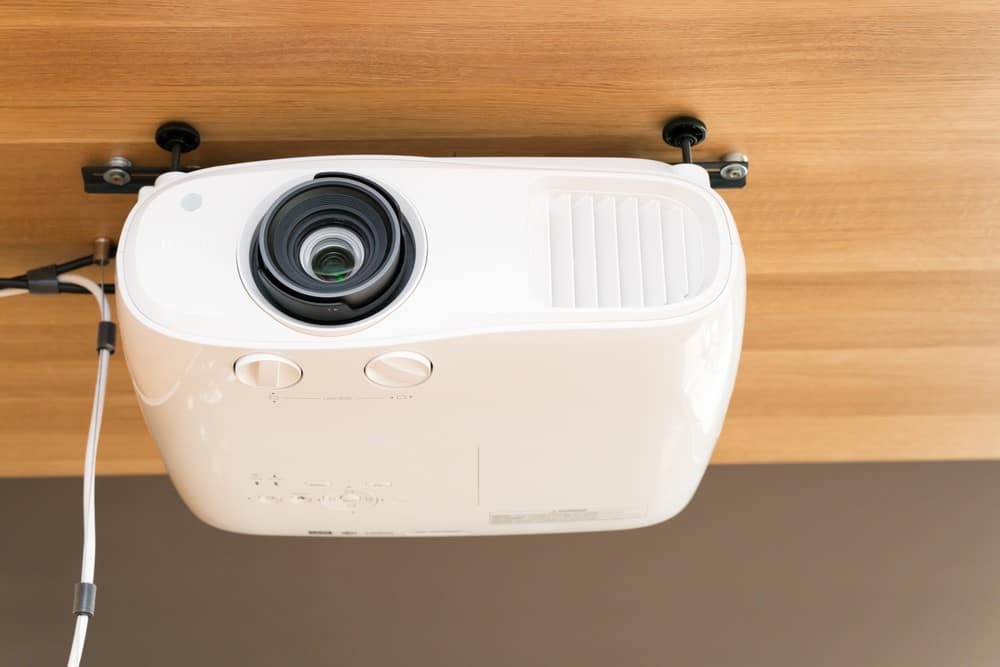
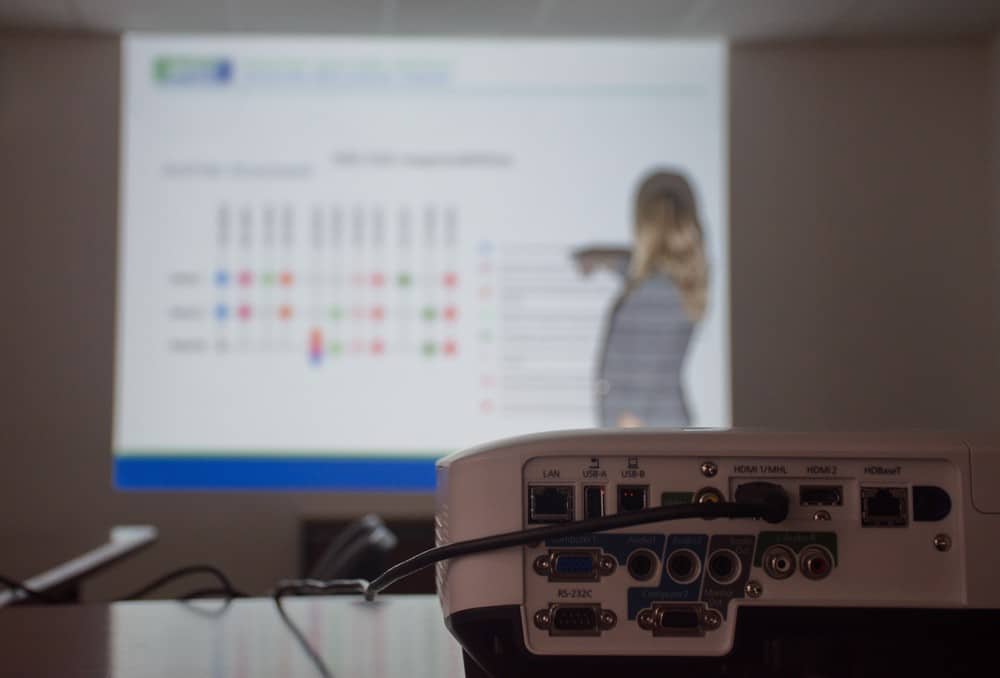
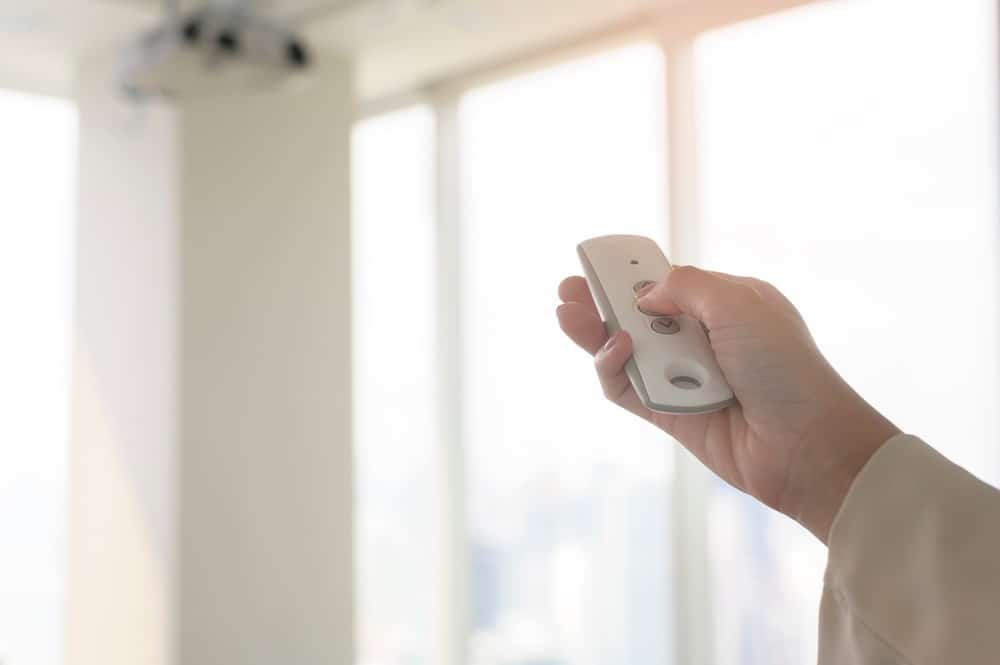
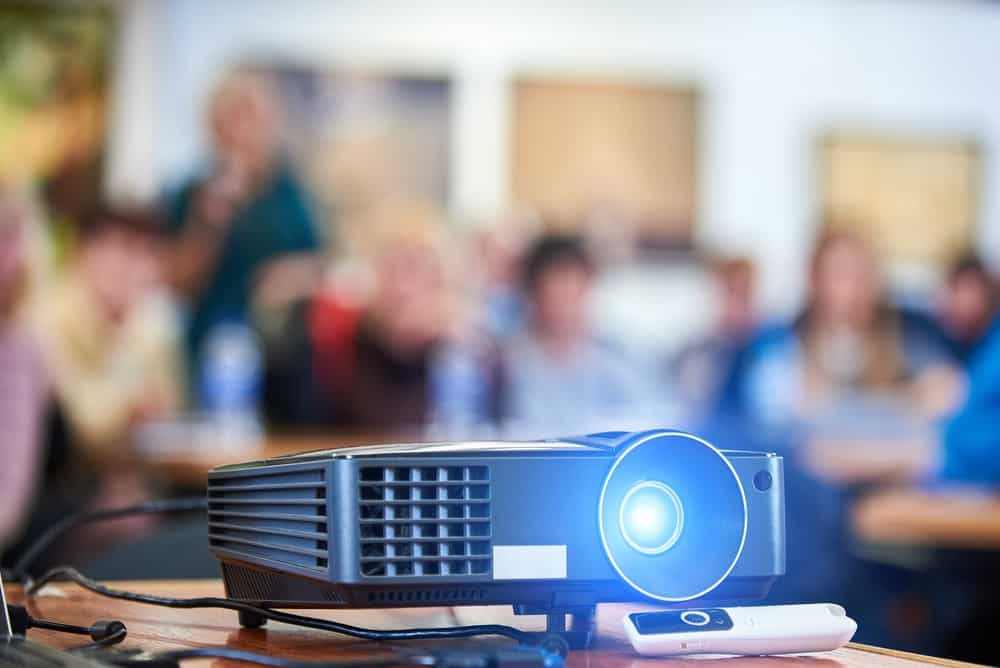

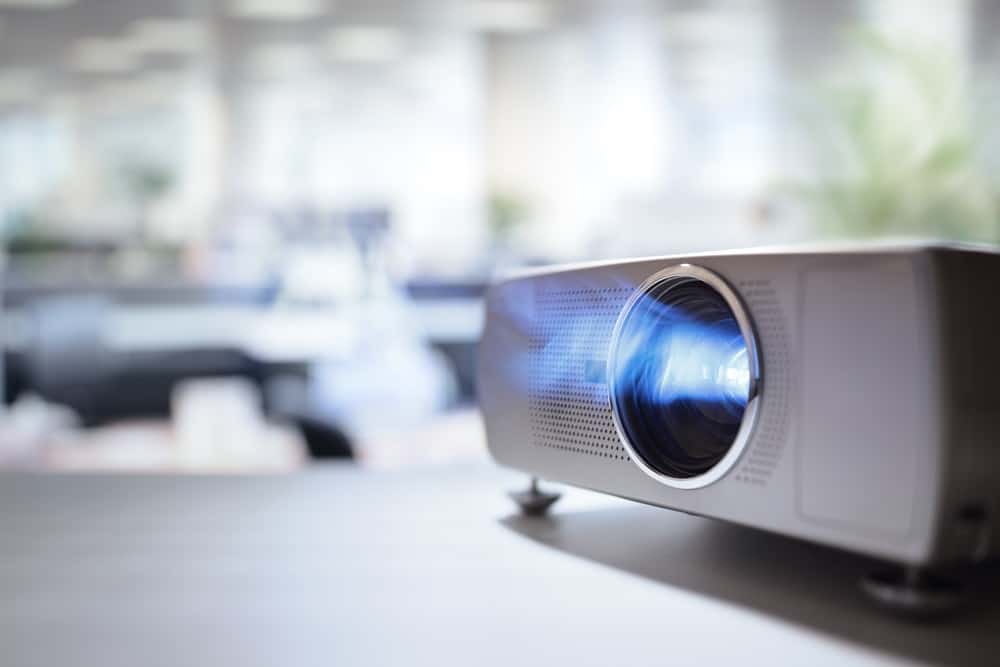
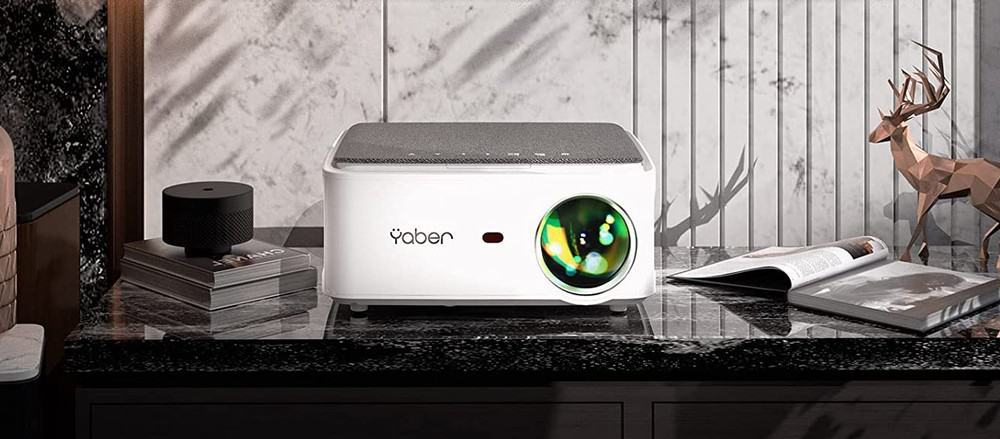
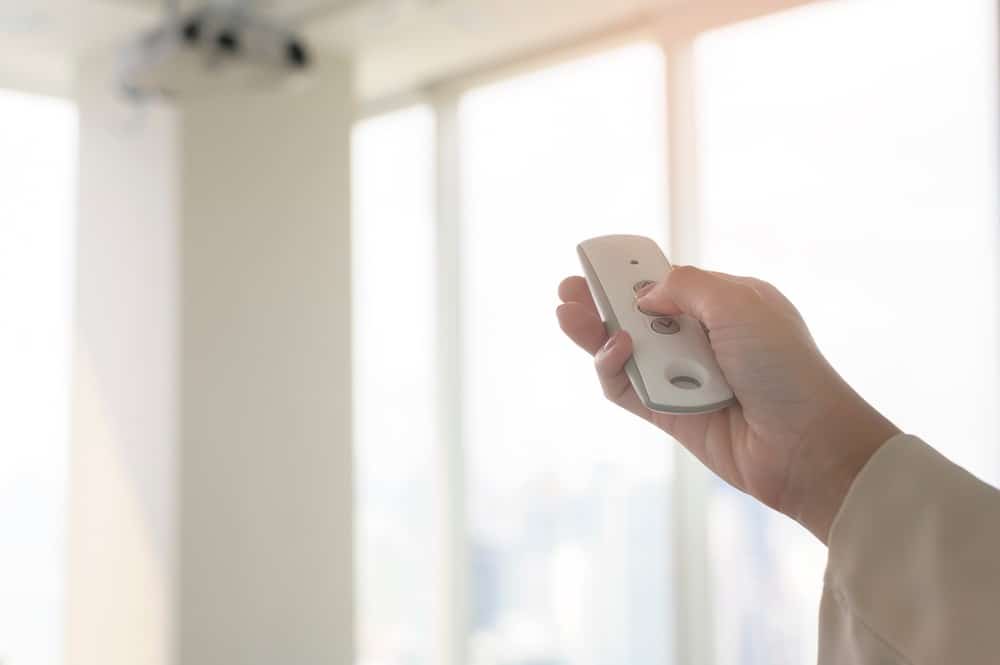
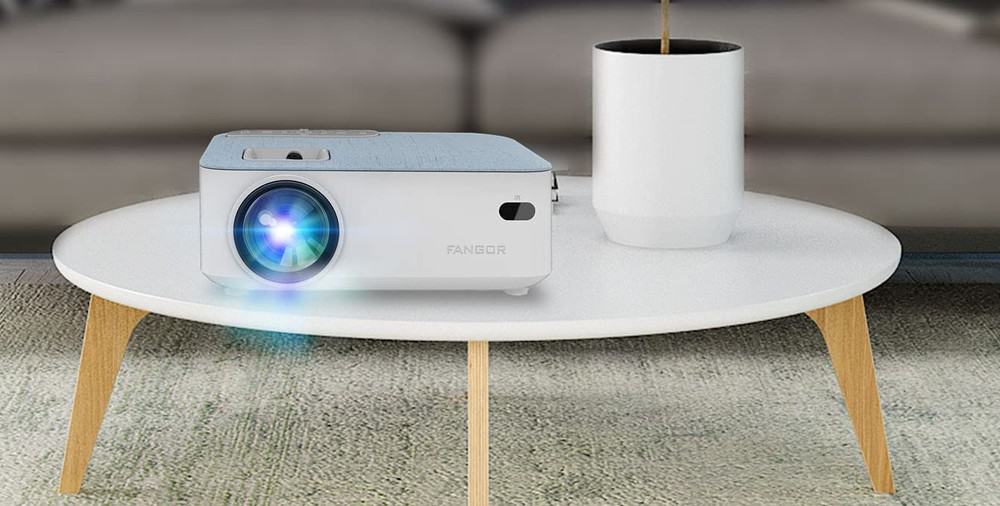
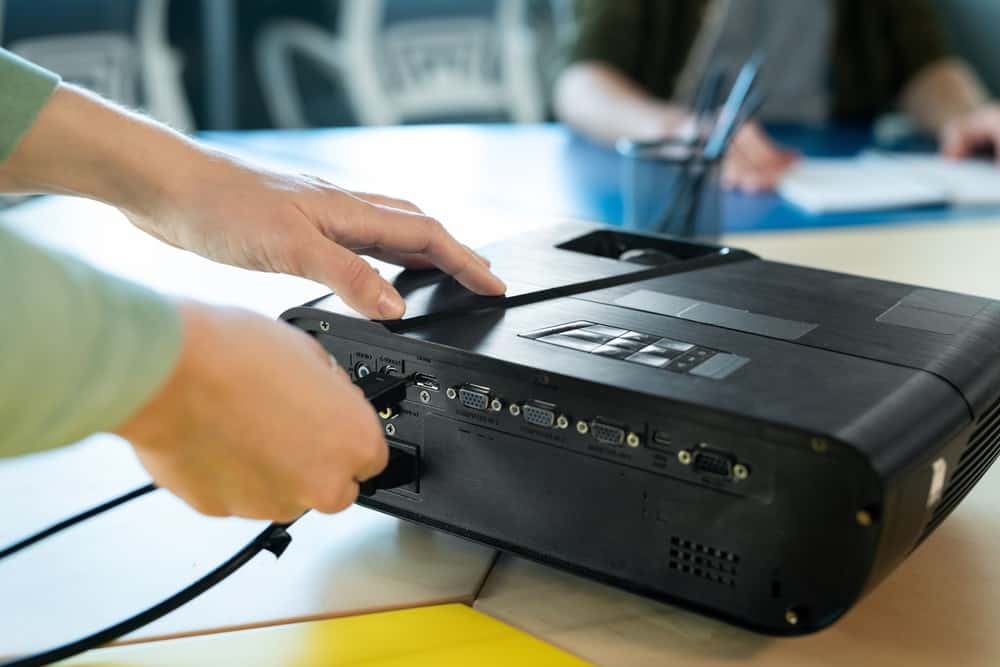
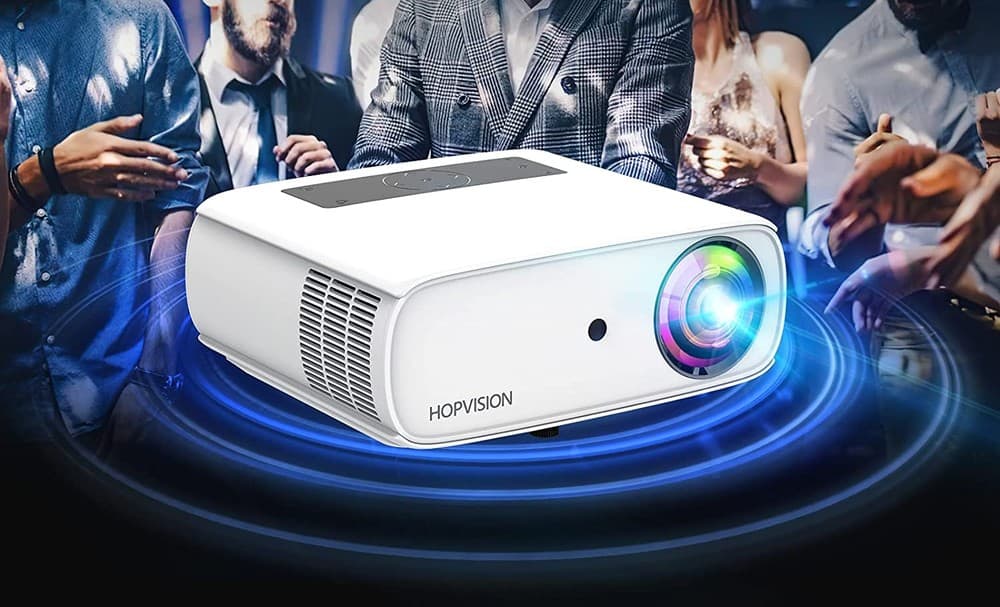

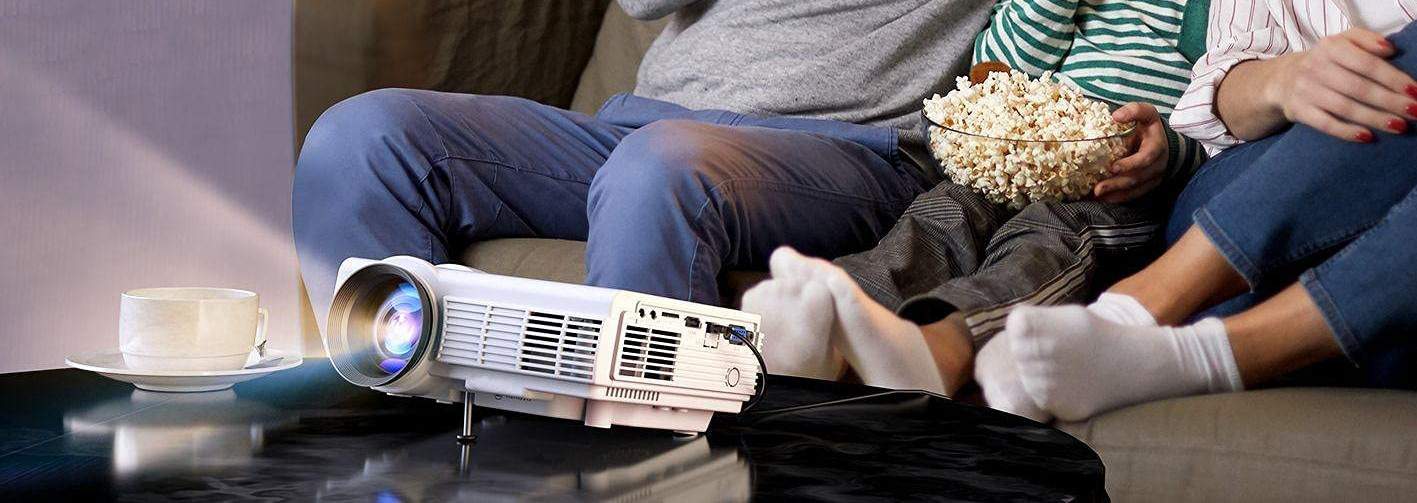
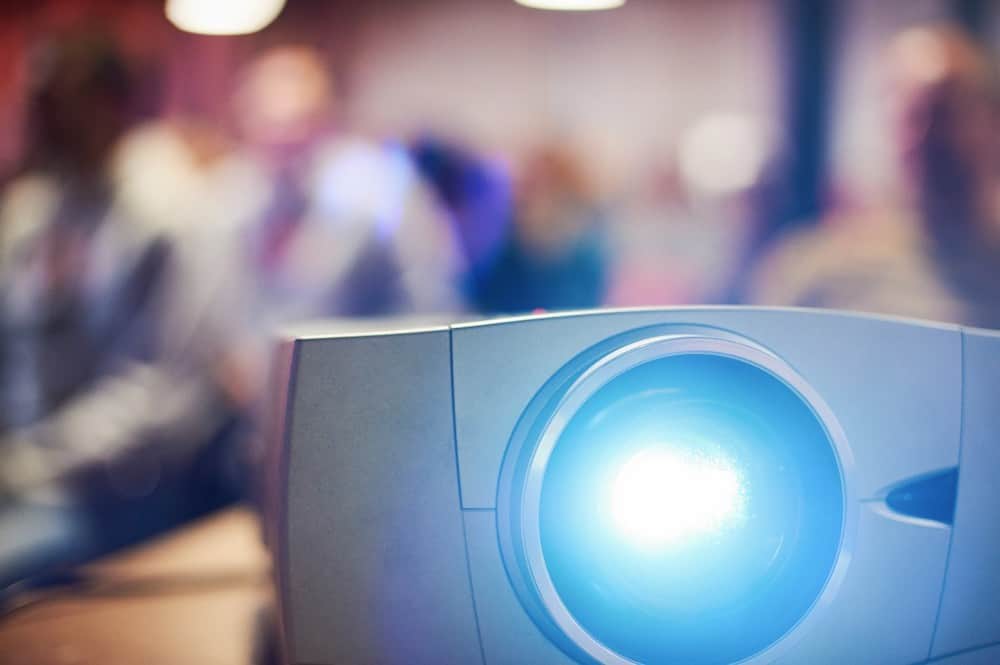
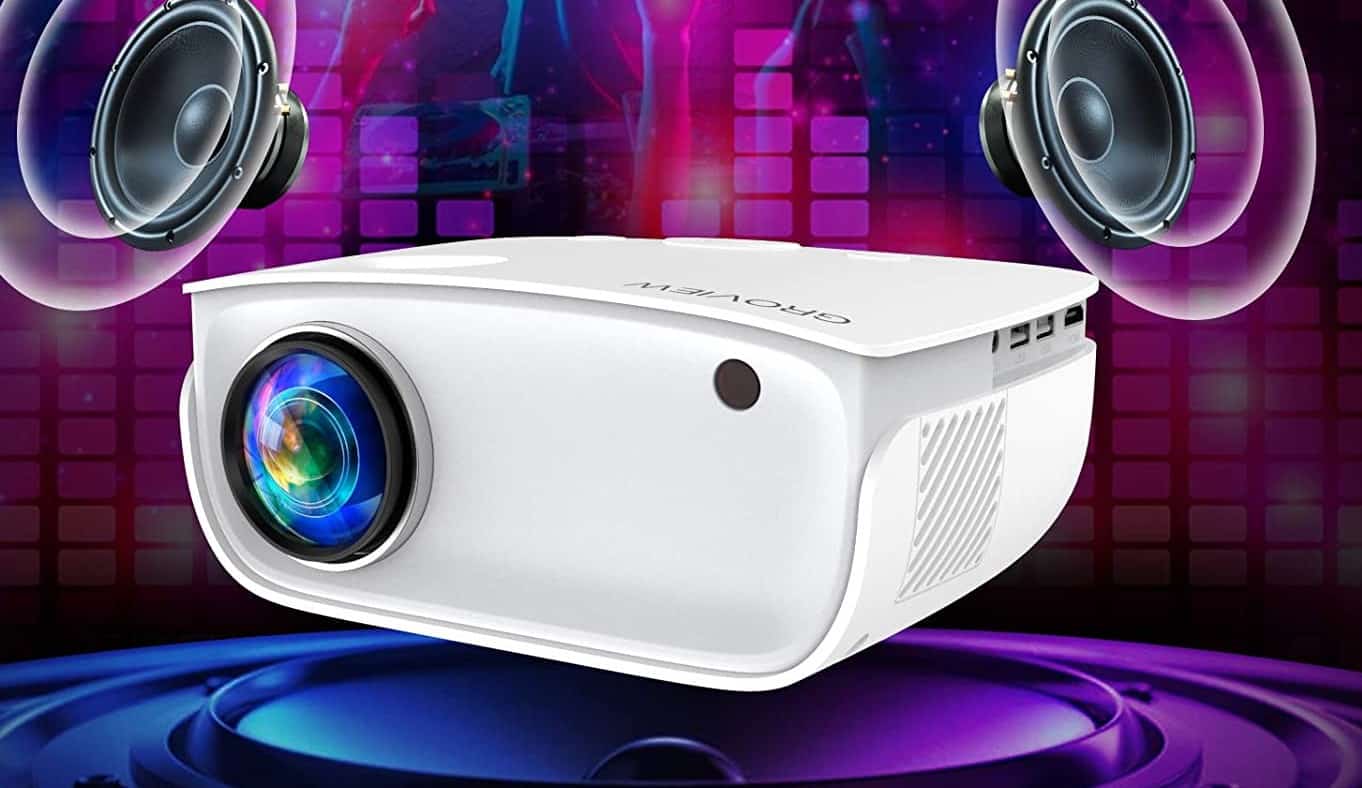
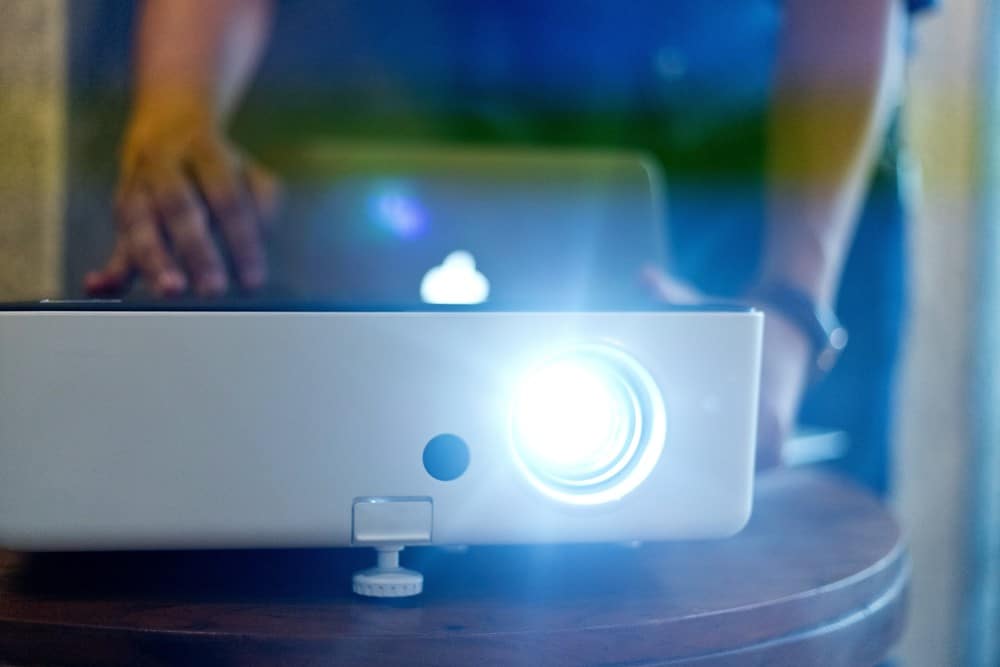

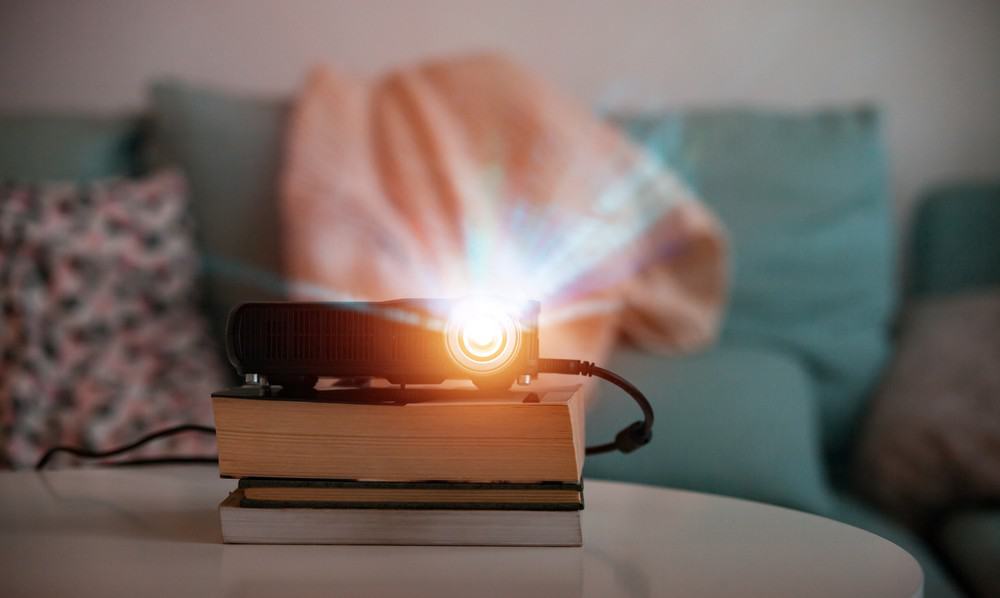
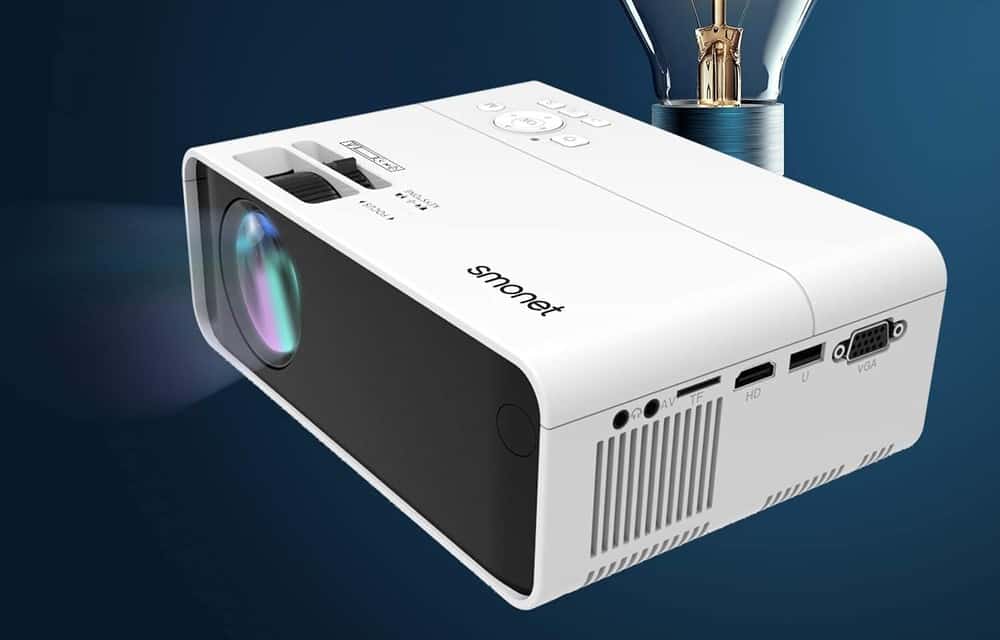
![Best Projectors for Daylight Viewing in [year] 34 Best Projectors for Daylight Viewing in 2025](https://www.gadgetreview.dev/wp-content/uploads/best-projector-for-daylight-viewing-image.jpg)
![Best Samsung Projectors in [year] 35 Best Samsung Projectors in 2025](https://www.gadgetreview.dev/wp-content/uploads/best-samsung-projectors-image.jpg)
![Best NEC Projectors in [year] 36 Best NEC Projectors in 2025](https://www.gadgetreview.dev/wp-content/uploads/best-nec-projectors-image.jpg)
![Best Acer Projectors in [year] 37 Best Acer Projectors in 2025](https://www.gadgetreview.dev/wp-content/uploads/best-acer-projectors-image.jpg)
![Best Quiet Projectors in [year] 38 Best Quiet Projectors in 2025](https://www.gadgetreview.dev/wp-content/uploads/best-quiet-projector-image.jpg)
![Best Projectors for Golf Simulator in [year] 39 Best Projectors for Golf Simulator in 2025](https://www.gadgetreview.dev/wp-content/uploads/best-projector-for-golf-simulator-image.jpg)
![Best InFocus Projectors in [year] 41 Best InFocus Projectors in 2025](https://www.gadgetreview.dev/wp-content/uploads/best-infocus-projectors-image.jpg)
![Best Mini Projector in [year] ([month] Reviews) 42 Best Mini Projector in 2025 (December Reviews)](https://www.gadgetreview.dev/wp-content/uploads/best-mini-projector-image.jpg)
![Best Panasonic Projectors in [year] 43 Best Panasonic Projectors in 2025](https://www.gadgetreview.dev/wp-content/uploads/best-panasonic-projectors-image.jpg)
![Best Sony Projectors in [year] 44 Best Sony Projectors in 2025](https://www.gadgetreview.dev/wp-content/uploads/best-sony-projectors-image.jpg)
![Best Projector Stands in [year] 45 Best Projector Stands in 2025](https://www.gadgetreview.dev/wp-content/uploads/best-projector-stand-image.jpg)
![Best Ultra Short Throw Projectors in [year] 46 Best Ultra Short Throw Projectors in 2025](https://www.gadgetreview.dev/wp-content/uploads/best-ultra-short-throw-projector-image.jpg)
![Best Projectors for a Living Room in [year] 47 Best Projectors for a Living Room in 2025](https://www.gadgetreview.dev/wp-content/uploads/best-projector-for-living-room-image.jpg)
![Best RCA Projectors in [year] 48 Best RCA Projectors in 2025](https://www.gadgetreview.dev/wp-content/uploads/best-rca-projectors-image.jpg)
![Best Optoma Projectors in [year] 49 Best Optoma Projectors in 2025](https://www.gadgetreview.dev/wp-content/uploads/best-optoma-projectors-image.jpg)
![Best BenQ Projectors in [year] 50 Best BenQ Projectors in 2025](https://www.gadgetreview.dev/wp-content/uploads/best-benq-projectors-image.jpg)
![Best Projectors for Church in [year] 51 Best Projectors for Church in 2025](https://www.gadgetreview.dev/wp-content/uploads/best-projector-for-church-image.jpg)
![Best Projectors for Classroom in [year] 52 Best Projectors for Classroom in 2025](https://www.gadgetreview.dev/wp-content/uploads/best-projector-for-classroom-image.jpg)
![Best Epson Projectors in [year] 53 Best Epson Projectors in 2025](https://www.gadgetreview.dev/wp-content/uploads/best-epson-projector-image.jpg)
